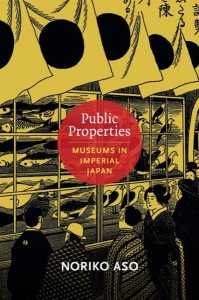JQ Magazine: Book Review — ‘Public Properties: Museums in Imperial Japan’

“Aso’s study is an intriguing, and refreshingly straightforward, examination of the shaping of the Japanese public in an era of increasing speed, change and modernization in the realm of how objects can promote, or even create, a national identity.” (Duke University Press)
By Jessica Sattell (Fukuoka-ken, 2007-08) for JQ magazine. Jessica is a freelance writer and a graduate student in arts journalism. Her favorite museum in all of Japan is the Fukuoka Asian Art Museum, but the Mori Art Museum is a close second.
Artist Barbara Kruger poses the pinnacle of questions in an untitled 1991 photograph and type-on-paper piece featuring a sunglasses-clad man whose mouth is twisted into a howl of wonder: “Why are you here?” She provides a few suggestions: “To kill time? To get ‘cultured’? To widen your world? To think good thoughts? To improve your social life?” When this piece is encountered within the walls of a gallery or art museum, these prompts can stir the viewer to question their place as a member of a larger conversation, rather than a simple viewer or consumer. This provokes further rumination: what do we feel when we go to museums, anywhere in the world? What connections do we have, or are we “supposed” to have, to an assortment of collected and cataloged objects arranged for public access? How are we shaped by social and political entities that can (and do) organize exhibitions around certain agendas? Design, of any kind, is never without direction.
Dr. Noriko Aso, Associate Professor of History at the University of California, Santa Cruz, addresses these, and several other powerful veins of inquiry, in her recently published book Public Properties: Museums in Imperial Japan (Duke University Press). She posits that the forerunner to the Japanese museum audience of today was shaped by governing bodies in a shift that brought state-safeguarded treasures out of storage houses and into public view. In this sense, museums in Imperial Japan (1868-1945) played a part far beyond that of the cultural repository and actually took on an active role in cultivating a Japanese national identity. Artworks, ancient artifacts and other cultural treasures helped to shape the self-representation of a self-actualized Japanese public.
Aso’s study is an intriguing, and refreshingly straightforward, examination of the shaping of the Japanese public in an era of increasing speed, change and modernization in the realm of how objects can promote, or even create, a national identity. As she strikingly points out, “Without a viewing public, a museum is simply a collection, not a cultural institution.” Indeed, the book outlines several ways to explore the idea of a museum as a site for examining its relevance: a physical architectural entity, as an assemblage of artworks or artifacts, or as a place for individuals to connect with abstract ideas in the forms of works or exhibits. She focuses on the last of these approaches, examining the “public” nature of museums at this point in Japanese history and the public crowds that made up “museum-goers” as directly connected to a Japanese state shaping a set of representations and expectations. The link, as she connects throughout the book, is that the emergence of a museum-patronizing public is directly related to “the cultivation of a modern national identity in Japan from the mid-nineteenth century.”
Aso goes further to examine this development—the emergence of museums in Japan and in Japanese colonial holdings as the mark of the country transforming into a modern nation—through dissecting museums as sites of encountering and shaping the notion of a “Japanese public” at several points of contact throughout the time period: through the actions of the central government; imperial holdings; organizing forces in Japan’s colonial outposts; and private collections from visionary individuals and consumer enterprises such as department stores. The study ties together approaches in art history, documentary, cultural studies and museology to address the notions of what constitutes shared cultural experience and the roles that public spaces continue to play in an ongoing renegotiation of our roles as members of a fabricated national consciousness.
This is a remarkably accessible text highlighting a set of ideas with implications and lessons that reach far beyond the case study’s time and place and straight into the musings of museum studies today, complete with reproductions of historical photographs, documentation and other ephemera that add a welcome visual touchstone to Aso’s detailed accounts. While the book traces the progression of the museum and the exhibition space in Japan (much like most of the world) from repository to encyclopedia to spectacle, one realization that ultimately emerges from the conclusion of Public Properties is that, while Aso outlines the beginnings of the history behind her approach to understand the development of museums in Japan, she poses it as an ongoing conversation, rather than a closed case; publics and public spheres continue to evolve and shift.
For more JQ magazine book reviews, click here.


Comments are closed.